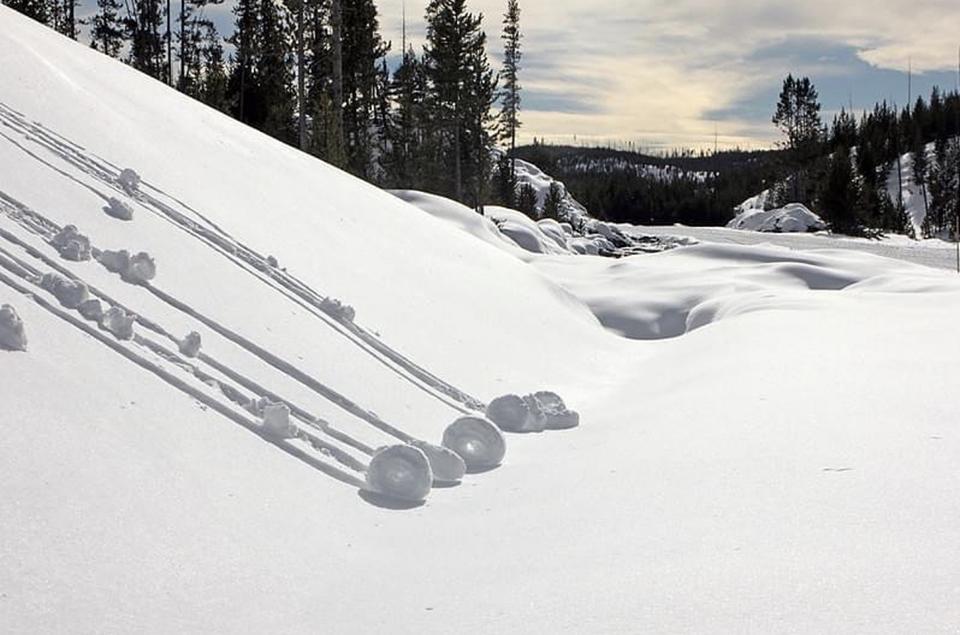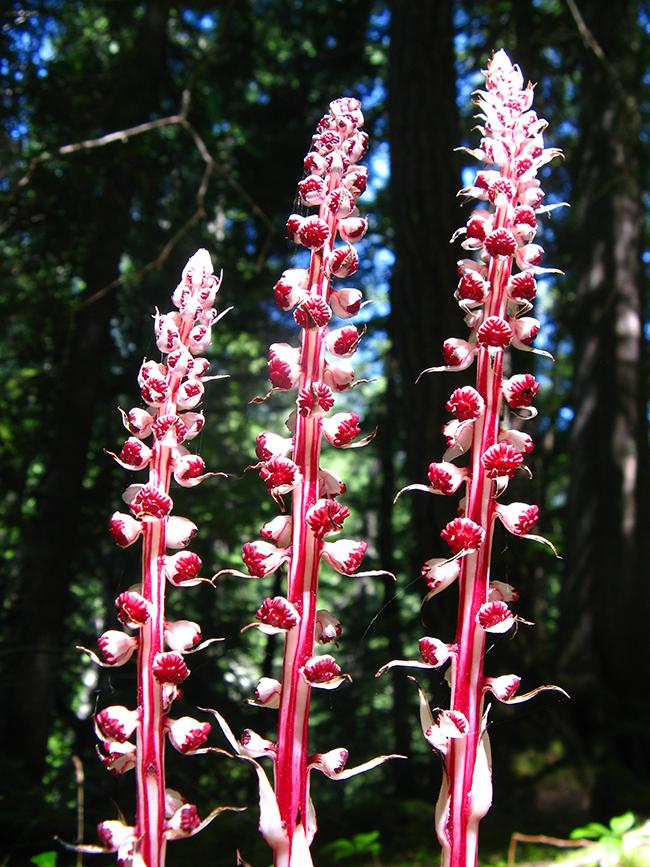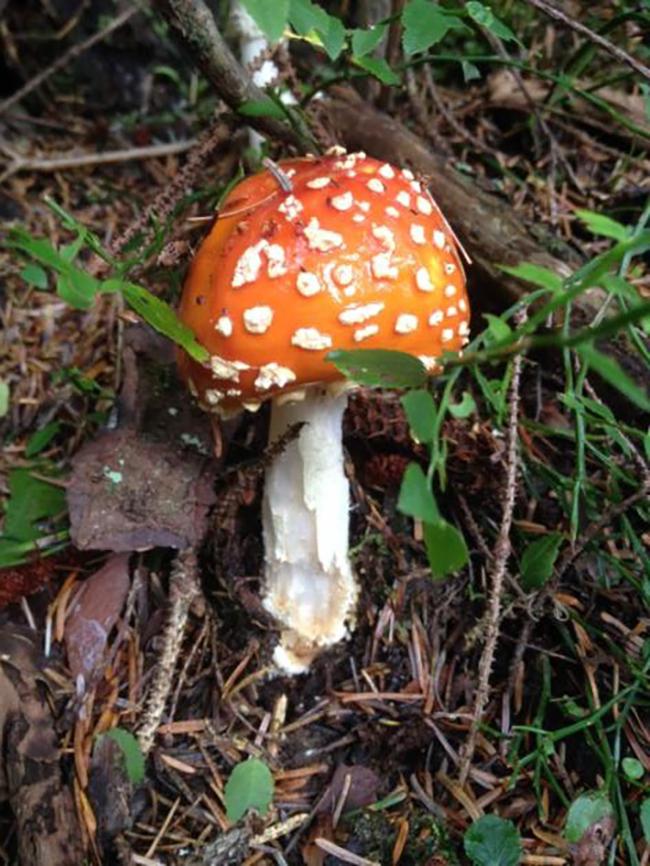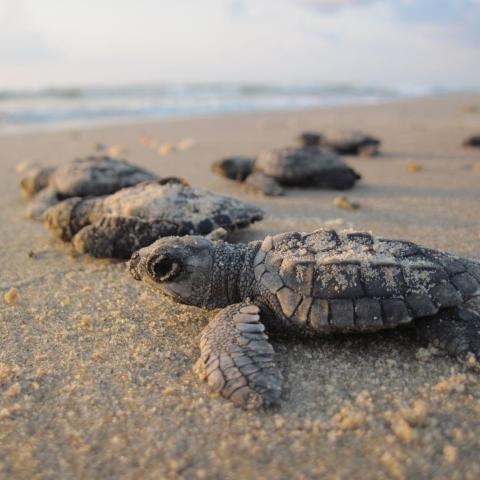
Colorful petrified logs along the Crystal Forest Trail, Petrified Forest National Park / Rebecca Latson
Happy New Year! Feeling ready for a 2023 round of quiz and trivia pieces? Let’s start with this one – first one of the year. See how much you know before checking the answers at the bottom of the page.
1. True or False: Much of the petrified logs you see during a visit to Petrified Forest National Park are strewn about in nice, cleanly cut segments. That’s because park staff have sawed them apart so you can see the beauty of the colorful log interiors.
a) True
b) False

A mountain laurel with stripped bark, Prince William Forest Park / NPS
2. “When hiking in the forest or driving along the roads at Prince William Forest Park in the late fall and early winter, you may notice some smaller trees that have been stripped of branches and bark.” This is caused by:
a) Bears rubbing against the tree trunks to scratch their backs
b) Beavers eating the more nutritious outer bark
c) Male deer rubbing their antlers against the bark to help shed the velvet on their antlers
d) Bobcats sharpening their claws on the bark

What are these little snow creations called? Yellowstone National Park / NPS
3. While snowshoeing or snowcoaching or snowmobiling the winter wonderland of Yellowstone National Park, you might see some interesting snowballs up to a few inches in width, with a long trail in their wake. These balls are called ___.
a) Snow pinwheels
b) Snow rollerballs
c) Snow rollers
d) Snow donuts

A quirky cactus, Organ Pipe Cactus National Monument / Jennifer Bain
4. This quirky saguaro cactus seen at Organ Pipe Cactus National Monument definitely does not look like its brethren around it. A genetic mutation has created what is known as a ___.
a) Cristate
b) Broccoli head
c) Fanned cactus
d) Scroller head

There's another name for these bits of snow, Mount Rainier National Park / NPS - S. Redman
5. Look at the image above of snow crystals blowing across the slopes at Paradise in Mount Rainier National Park. They are known as ___.
a) Fairy crystals
b) Snow sparklies
c) Icy sparkles
d) Hydrometeors

A slimy sculpin, Denali National Park and Preserve / NPS - M.J. Kilfeather
6. This odd little creature found in Denali National Park and Preserve is called the slimy sculpin, one of ___ fish species found in this park.
a) 8
b) 19
c) 22
d) 31

A patch of snow fleas, Yellowstone National Park / NPS
7. While hiking around in the snow at Yellowstone National Park, you might notice a patch of snow with what look like little poppy seeds scattered all over. Those are snow fleas, also known as ___>
a) Springtails
b) Pepper fleas
c) Poppy bugs
d) Caraway fleas

Mmm! Minty fresh? Mount Rainier National Park / NPS - Bev Killam
8. While hiking around the shady woods of Mount Rainier National Park, you might come across this yummy-looking little plant, known as a __.
a) Peppermint stick
b) Candycane plant
c) Candystick plant
d) Christmas candy plant

Sunrise over the Gulf of Mexico, Padre Island National Seashore / Rebecca Latson
9. This beautiful pink band stretching from one end of the horizon to another over Padre Island National Seashore is an atmospheric phenomenon called ___.
a) Venus’s Girdle
b) Antitwilight arch
c) Belt of Venus
d) Blue Hour line

Pretty edible, or pretty poisonous? Sitka National Historical Park / NPS
10. While hiking the forests of Sitka National Historical Park, you might chance upon a beautiful and bright orange-red mushroom dotted with white spots. The Amanita muscaria is also called ___.
a) Peach fungus
b) Stinkhorn
c) Orange umbrella
d) Fly agaric
Trivia

The beauty of an obsidian arrowhead, Bandelier National Monument / NPS
“Obsidian, also known as volcanic glass, is the result of volcanic lava cooling rapidly when in contact with air or water, producing a dark, shiny rock with no crystal structure. Obsidian deposits are found on Bandelier National Monument’s northwest edge and elsewhere in the Jemez Mountains. Obsidian is very hard and brittle and breaks in conchoidal fractures (a fracture with smooth, curved surfaces, typically slightly concave, showing concentric undulations resembling the growth lines of a shell). Since it can be chipped to create extremely sharp edges, it was the perfect material for making hunting points and cutting tools. Because obsidian of high quality for making arrowheads, knives, and scrapers was readily available from the Jemez Mountains, it was an essential trade item for the Ancestral Pueblo people. With modern microscopic analysis confirming the location of the origin of archaeological finds, it can be determined that obsidian from the Jemez Mountains was traded to distant places in exchange for items such as copper bells, macaws and their feathers, and bison.”

Bedrock mortars, Big Bend National Park / NPS - C. Negele
“Have you seen holes like these while hiking the trails in Big Bend National Park? Some outcrops of slickrock in Big Bend display groups of holes that look like they could be natural creations, but their smooth sides and similar size indicate they are bedrock mortars. Bedrock mortars are archaeological features once used by indigenous hunter-gatherer bands of Big Bend to prepare food. As the name suggests, bedrock mortars are a mortar and pestle built into surface stone. Native peoples returned to these sites to grind seeds and vegetation for consumption using stone or wooden pestles. Baked sotol and lechuguilla, piñon nuts, and prickly pear fruits are among the foods once prepared in the mortars … Boquillas Canyon and the Rio Grande Village Nature Trail are the best places to see bedrock mortars.”

Female blue crab, Cape Hatteras National Seashore / NPS - J. Weaver
“The blue crab (Callinectes sapidus) translated from Latin means ‘beautiful savory swimmer.’ Although blue crab claws are bright blue, the mature females have extra red tips on their claws! Another differentiator is the apron (plate on the bottom of the crab used to determine the sex). The female blue crab has an apron that’s triangular on young females and rounded and circular on older females. A male blue crab has a T-shaped apron (think Washington Monument). Blue crabs are abundant on Cape Hatteras National Seashore and thrive in salt marshes and brackish estuaries, such as the Pamlico Sound.
Quiz Answers
1b False
I know – a “gimme.” But hey, I thought I’d start with an easy question for the first of the year. No, park staff do NOT saw the petrified trees into segments. Petrified wood is mostly silica – not the pure silica of quartz, but it has silica mixed with other minerals. The logs are very hard (5.5 to 6 on the Moh’s 1-10 scale of hardness), but brittle. After petrification, but while still encased in matrix rock, the logs cracked under stress. As the logs eroded out, from gravity and ice wedging, the cracks widened and segments separated. Silica naturally breaks on a clean angle. To physically cut these petrified logs, you’d need a diamond saw like rock shops use when slabbing any rock composed mainly of silica.
2c
“Antler velvet is a soft furry membrane that covers antlers through the spring and summer. It covers the veins that supply blood and nutrients to the antlers to stimulate their growth. Antlers are considered to be the fastest growing tissue in the animal world! In the fall, as their testosterone rises, male deer no longer need the velvet as their antlers harden. The velvet starts to dry and flake off, and the deer rub and polish their antler on trees and bushes to get rid of the persistent itch.”
3 All of the above
While the National Park Service writes that these interesting snow creations are “the cold weather equivalent of tumbleweeds,” and form as a result of wind pushing the snow across the ground and gathering it into a hollow cylinder, wind is perhaps just one of the mechanisms for forming these snow “tumbleweeds,” with the main formation coming from snow falling in clumps from trees and rocks due to gravity and then rolling downhill on warm days when the snow is wet enough to stick together. In addition to spotting them in Yellowstone, you’ll see these snow pinwheels all along the roadside during the winter in Mount Rainier National Park.
4a
“Cristate or ‘crested’ saguaros form when the cells in the growing stem begin to divide outward, rather than in the circular pattern of a normal cactus. This is an unusual mutation which results in the growth of a large fan-shaped crest at the growing tip of a saguaro's main stem or arms.” You can read more about Organ Pipe Cactus National Monument and its denizens by clicking here.
5d
“The Pacific Northwest is famous for its hydrometeors, which are liquid or solid water particles suspended in the atmosphere. You may be more familiar with their other names, such as rain, snow, hail, etc. Once the hydrometeor settles on the ground, it is no longer a hydrometeor, but it can become one again if blown by the wind …”
6b
“The slimy sculpin is one of 19 fish species found in Denali National Park and Preserve. Slimy sculpin inhabit the cold streams of Denali year-round, feeding on aquatic insects. Male slimy sculpin protect their eggs and have been seen protecting their young after they hatch, as well.
7a
“Snow fleas, also known as springtails, are a common sight on warm winter days. These tiny animals live in the soil and eat leaf litter and other organic material. In winter, they often appear on the surface of the snow – sometimes in a dusting like pepper, sometimes in thick clumps. They might be looking for food but they haven’t been studied enough to know for sure.
8c
“Candystick (Allotropa virgata) have red and white stripes instead of green leaves and don’t use photosynthesis for energy. Instead, they form a complicated three-way relationship with fungus and coniferous fir trees to survive. The candystick draws energy from the fungus associated with its roots. The fungus in turn derives energy from tapping into the roots of fir trees. With no need for the sun, candystick can be found in the shady, deep woods of Mount Rainier.
9a, b, and c
If you picked any of these three answers, you would be correct, since ALL of them are names for the same atmospheric phenomenon. According to skyatnightmagazine.com, “As the sun rises in the east or sets in the west, sunlight reflects off the dense atmosphere in an effect called backscattering, which creates a pink band of light on the opposite horizon to the Sun, above the antisolar point. This pink band is the Belt of Venus,” which appears above the Earth’s shadow (the blue line above the horizon).
10d
“Appearing in the late summer and fall, the fly agaric emerges from a distinctive cup. It is lined with concentric rings on the lower part of its stem. This can be difficult to see because this can lie beneath the soil or leaf litter, an example of how easy it is for an amateur to make a deadly mistake in identification. Most mushroom poisonings are due to ingesting mushrooms that are mistakenly identified as edible.”




 Support Essential Coverage of Essential Places
Support Essential Coverage of Essential Places






